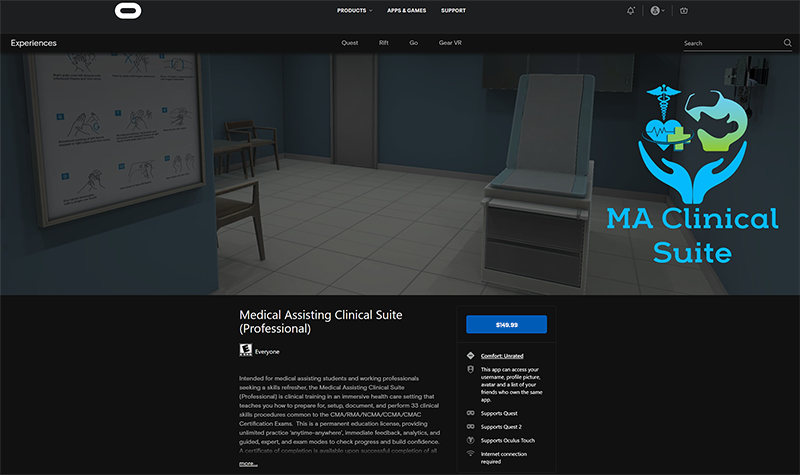A medical assistant may be asked to perform ear irrigation and to instill ear medication. This skill lab teaches you how to prepare for, setup, document, and perform ear irrigation to remove excess cerumen or foreign materials from the ear, and to instill ear medication.
This lab is based on the entry-level competencies for which the Commission on Accreditation of Allied Health Education Programs (CAAHEP) and Accrediting Bureau of Health Education Schools (ABHES) test the Medical Assistant.
Learning Sequence Builds Confidence
The learner practices the procedure in the ‘guided mode’ (interaction hints and an expanded checklist guide) as often as they like.
When the learner is confident that they can accurately demonstrate the procedure without error, the learner plays the level in the ‘expert mode’ (no hints or checklist explanations) - which they can repeat as often as they wish.
Finally, when the learner is confident that they have mastered the procedure - they take a one-time ‘exam’ attempt which results in their grade for that procedure.
The Medical Assisting Clinical Suite (Professional) Edition is available for purchase through the Oculus AppLab for $149.99
Features
Guided Mode - ghosted hints show step-by-step positions, learner can 'see through' the patient to verify placement.
Oculus Quest Affordability & Ease of Use - next generation game development processes allow the untethered, mobile VR to present effective visual and interaction fidelity at 1/4 of the cost of desktop VR.
Feedback - Cloud-based enterprise incorporates real-time data acquisition that allows learner to track progress and mastery, and provides detailed insights for debrief with faculty.
Support - Enterprise incorporates Knowledge Base (with tutorial videos & FAQ) - combined with help desk support staff for learners and staff.
Irrigate Ear and Instill Medication Checklist
- Perform hand hygiene.
- Assist the patient to assume the position, which allows a good view.
- Straighten the external ear canal by gently pulling the auricle upward and backward for adults, and downward and backward for a child.
- Turn on the otoscope light and insert the otoscope speculum into the external ear canal.
- Observe the external ear canal and the tympanic membrane for abnormalities.
- Position the patient for irrigation. The patient should be positioned with his head tilted slightly towards the affected side.
- Drape the patient. Drape his shoulder with absorbent pads under the affected ear; cover the shoulder and the upper arm area.
- Fill the irrigating syringe.
- Test the flow of solution from the syringe. Expel a small quantity of solution back into the container.
- Position the emesis basin.
- Straighten the ear canal.
- Place the tip of the irrigating syringe just inside the meatus of the ear, with the tip directed toward the roof of the ear canal. Depress the bulb or plunger on the irrigating syringe. Direct a slow, steady stream of irrigating solution against the roof of the ear canal.
- Remove the emesis basin and dry the external ear
- Tell the Patient to keep tilting his head.
- Check the label on the ear drop solution against the physician’s order.
- Warm the ear drop solution container with your hand.
- Position the patient for instillation. The patient should be positioned with his head tilted slightly away from the affected side.
- Instill ear medication.
- Place a cotton ball in the ear.
- Close ear drop solution, remove and discard gloves.
- Perform hand hygiene.
- Document the procedure and findings according to agency policy.

